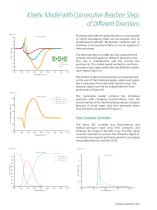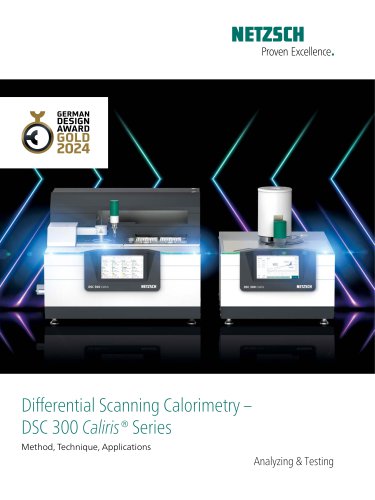 Website:
NETZSCH Analyzing & Testing
Website:
NETZSCH Analyzing & Testing
Group: NETZSCH
Catalog excerpts

How fast are chemical reactions? kinetics.netzsch.com Kinetics Neo Kinetic Analysis Software for Thermal Measurements of Chemical Reactions. Model-Free and Model-Based Methods Analyzing & Testing
Open the catalog to page 1
Substances with well-defined properties can be converted into other substances with different properties by the chemical reactions of a set of reactants. Reactions can run their course within a fraction of a second, as with explosions, or can take thousands or even million of years, as with the formation of minerals. Kinetics, also called reaction kinetics or chemical kinetics, investigates the rates of chemical processes and allows for the determination of reaction rates. Prediction of degree of cure including determination of the curing time during material changes. The simulation...
Open the catalog to page 2
can analyze any process for which the rate depends on temperature NETZSCH Kinetics Neo software is used to analyze kinetics of temperaturedependent chemical processes. The result of such analysis is a kinetics model or method correctly describing experimental data under different temperature conditions. Use of the method/model allows for predictions of a chemical system’s behavior under user-defined temperature conditions. Alternatively, such models can be used for process optimization. The software can analyze different types of thermal curves that depict the changes in a given material...
Open the catalog to page 3
Model-Free Analysis for lows free l a o e odeltics N Kine of both m ethods. dm se the u odel-base and m Starting Points for a Kinetic Analysis Each kinetic analysis requires a set of analytical measurements carried out under different temperature conditions. These can include dynamic test runs using different heating rates or isothermal measurements monitored at different temperatures. Even a combination of dynamic and isothermal measurements is suitable for kinetic studies. The Basics of Model-Free Analysis Model-free analysis allows for the determination of the activation energy of a...
Open the catalog to page 4
There Is No Assumption of the Reaction Type The Model-Free Analysis Methods – Advantages and Disadvantages The Friedman analysis is an isoconversional method whereas the Ozawa-Flynn-Wall (OFW) and KissingerAkahira-Sunose (KAS) analyses are integral isoconversional methods. In all methods, the measurements are analyzed for multiple levels with the same conversion. Friedman requires at least two measurements. In addition to two dynamic measurements, OFW and KAS require positive heating rates. The Numerical Optimization uses digital simulation in determining the activation energy and...
Open the catalog to page 5
s– netic tages i K d an se ds el-Ba isadv Mod All the D is Metho s ys nate Anal Elimi del-Free o of M Model-Based Kinetics for Comprehensive Analysis of Chemical Reactions The extraordinary model-based analysis was developed by NETZSCH. It uses powerful cutting-edge mathematical calculations to create the best kinetic model; the different kinetic models can then also be compared statistically. Therefore, this approach has none of the disadvantages which can be observed when using model-free methods. The Unique Model-Based Analysis The Model-Based Kinetic Analysis Is Based on Three...
Open the catalog to page 6
Kinetic Model with Consecutive Reaction Steps of Different Directions Model Based Figure A Model Based Model Based Conversion Rate / Conversion (%/min) Rate / (%/min) Concentration Conversion Rate / (%/min) DSC / mW/mg Model Based 10.1 K/min 160 170 Fit 5.0 K/min Fit 2.0 K/min Fit 5.0 K/min 5.0 K/min, Sum 10.1 K/min 5.0 K/min, A -> B 150 160 170 Fit 5.0 K/min, B -> C 5.0 K/min Fit 2.0 K/min Fit 5.0 K/min 5.0 K/min, Sum 1505.0 K/min, 160 A -> 170 B 5.0 K/min, B -> C 5.0 K/min 5.0 K/min, Sum 5.0 K/min, A -> B 5.0 K/min, B -> C 150 160 170 Temperature /°C Model Based 5.0 K/min, A 5.0 K/min, B...
Open the catalog to page 7
Kinetics Neo Includes a Variety of Reaction Types Code Two-dimensional phase boundary Three-dimensional phase boundary One-dimensional diffusion Two-dimensional diffusion Three-dimensional diffusion – Jander’s type Three-dimensional diffusion – Ginstling-Brounstein Prout-Tompkins equation Expanded Prout-Tompkins equation Extended Sestak-Berggren equation Reaction of 1st order with autocatalysis by product Reaction of nth order with autocatalysis by product f = en·(1 + AutocatOrder·pm) Reaction of nth order with autocatalysis of mth order by product Two parallel reactions with the same...
Open the catalog to page 8
Mass loss Climatic 150 Optimization Conversion rate Signal rate (RCM for thermogravimetry and RCS for dilatometry) Mass loss This feature allows for the simulation of data once the experimental data is described by model-free or model-based kinetics. The temperatureT3 T2 profile can be calculated and optimized taking into account defined T1 boundary conditions; e.g., constant or user-defined conversion rate, constant signal rate, temperature range and range of heating rates. The results depend on the chosen model-free or model-based method and its parameters. Careful kinetic analysis of the...
Open the catalog to page 9
What Makes Kinetics Neo So Valuable ... Completely rewritten from scratch, this innovative software is based on the latest technologies. The improved user interface is fast and easy to operate. All model-free and model-based methods are included. The results from all of these methods can be statistically compared with one another. The powerful new numerical model-free method ensures fast determination of the best model-free solution. Predictions and optimizations can be achieved by means of both model-free and model-based methods. A visual kinetic model can be created quickly and easily...
Open the catalog to page 10
1,9 K/min Fit 0,5 K/min Fit 1,0 K/min Fit 0,7 K/min Fit 1,5 K/min Fit 3,4 K/min K/min 1,9 Fit 1,9 Fit K/min 0,2 K/min K/min 0,5 Fit Fit 0,5 Fit K/min 1,9 K/min K/min 1,0 Fit Fit Fit 1,0 K/min 200 0,5 K/min K/min 0,7 Fit Fit 0,7 Fit K/min 1,0 K/min K/min 1,5 Fit Fit 1,5 Fit K/min 0,7 K/min K/min 3,4 Fit Fit 3,4 Fit K/min 1,5 K/min K/min 0,2 Fit Fit 0,2 Fit K/min 3,4 K/min Fit Fit 200 0,2 K/min 200 Fit If the glass transition occurs during the cross-linking of a thermoset, the reaction is divided into two areas which are dominated by different mechanisms: The part above the glass transition...
Open the catalog to page 11All NETZSCH Analyzing & Testing catalogs and technical brochures
-
DSC 300 Caliris Series
28 Pages
-
STA 509 Jupiter Series
28 Pages
-
TG 309 Libra Series
24 Pages
-
DEA 288 Ionic
20 Pages
-
STA 2500 Regulus
12 Pages
-
NTA Guarded Hot Plate Series
16 Pages
-
TMA 402 F1/F3 Hyperion®
16 Pages
-
Rosand Series
20 Pages
-
Accelerating Rate Calorimetry
20 Pages
-
LFA 467 HyperFlash® Series
28 Pages
-
DMA 303 Eplexor
24 Pages
-
NTA HotBoxes
16 Pages
-
DIL 402 Expedis Select/Supreme
28 Pages
-
DIL 402 Expedis Classic
16 Pages
-
Product Overview
12 Pages
-
NETZSCH Energy Solutions
40 Pages
-
Advanced Materials Testing
32 Pages
-
NTA Fire Testing Systems
20 Pages
-
TG-FTIR - product brochure
24 Pages
-
TA-QMS Coupling
28 Pages
-
Kinexus Prime DSR Series
20 Pages
-
Kinexus Prime Series
20 Pages
-
HMOR 422
1 Pages
-
RUL/CIC 421
1 Pages
-
Cone Calorimeter TCC 918
12 Pages
-
Thermal Insulation Materials
24 Pages
-
SBA 458 Nemesis®
24 Pages
-
NETZSCH NEVIO Instrument Series
24 Pages
-
LFA 427 - product brochure
24 Pages
-
DMA GABO EPLEXOR up to 1500°C
12 Pages
-
GABOMETER®
8 Pages


























































